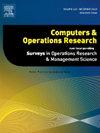重新考虑紧凑措施:生态保护区设计的多目标框架
IF 4.3
2区 工程技术
Q2 COMPUTER SCIENCE, INTERDISCIPLINARY APPLICATIONS
引用次数: 0
摘要
该研究旨在开发一种精细的紧凑度度量,紧凑度是保护区设计中影响生态和经济效率的关键空间属性。生态保护区的设计往往涉及相互冲突的目标,需要同时考虑空间属性和生态多样性。我们引入了一种新的度量,在测量储备密实度时兼顾了尺寸和形状。此外,我们采用多目标优化来生成帕累托最优解决方案,为利益相关者提供一系列高质量的储备配置。当集群代表不同的栖息地,生物相互作用有限时,我们对紧凑性的关注尤为重要。我们比较了各种紧凑度量,如边界长度和成对距离,并评估了它们在优化模型中包含的适用性。这种方法解决了不同利益相关者的优先事项,导致更平衡的储备选择。我们展示了单目标方法的缺点,通常会产生次优的、非紧凑的储量,并强调了跨多个指标优化的优势,以更好地捕捉储量设计的复杂性。本文章由计算机程序翻译,如有差异,请以英文原文为准。
Reconsidering compact measures: A multiobjective framework for ecological reserve design
This study aims to develop a refined compactness measure, a key spatial attribute in reserve design that impacts both ecological and economic efficiency. Designing ecological reserves often involves conflicting objectives, necessitating the simultaneous consideration of spatial attribute and ecological diversity. We introduce a novel metric that accounts for both size and shape in measuring reserve compactness. Additionally, we employ multiobjective optimization to generate Pareto-optimal solutions, offering stakeholders a range of high-quality reserve configurations. Our focus on compactness is particularly relevant when clusters represent distinct habitats with limited biological interactions. We compare various compactness measures, such as boundary length and pairwise distance and evaluate their suitability for inclusion in optimization models. This approach addresses diverse stakeholder priorities, leading to more balanced reserve selections. We demonstrate the shortcomings of single-objective approaches, which often yield suboptimal, non-compact reserves, and highlight the advantages of optimizing across multiple metrics to better capture the complexities of reserve design.
求助全文
通过发布文献求助,成功后即可免费获取论文全文。
去求助
来源期刊

Computers & Operations Research
工程技术-工程:工业
CiteScore
8.60
自引率
8.70%
发文量
292
审稿时长
8.5 months
期刊介绍:
Operations research and computers meet in a large number of scientific fields, many of which are of vital current concern to our troubled society. These include, among others, ecology, transportation, safety, reliability, urban planning, economics, inventory control, investment strategy and logistics (including reverse logistics). Computers & Operations Research provides an international forum for the application of computers and operations research techniques to problems in these and related fields.
 求助内容:
求助内容: 应助结果提醒方式:
应助结果提醒方式:


